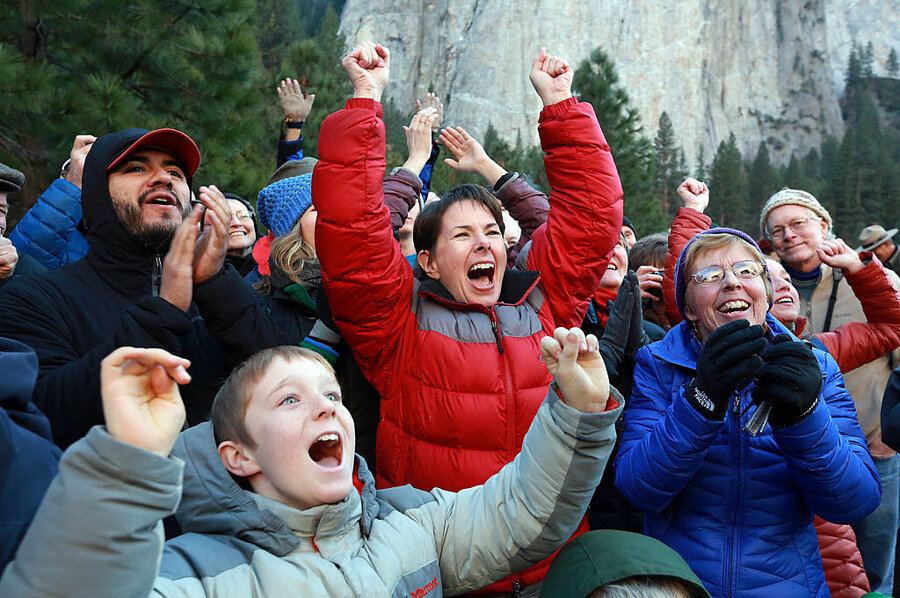Conquering El Capitan and five other 'impossible' feats
Loading...
On Wednesday, two young Americans succeeded in scaling what many considered the world’s most difficult rock to climb. After a 19-day ordeal that included numerous falls and injuries, Tommy Caldwell and Kevin Jorgeson became the first people to successfully free climb El Capitan's Dawn Wall in Yosemite National Park in California. The pair used ropes and harnesses to catch them when they fell, but just their hands and feet to pull themselves up the 3,000-foot vertical wall of granite.
The feat was celebrated across the country. Even President Obama tweeted his congratulations to the pair, claiming that the men “remind us that anything is possible.” Now, as the world celebrates this latest triumph, it’s worth looking back at some of the other great feats of history, when people succeeded in accomplishing what was previously though to be impossible.
In May 1954, on a dusty track in Oxford, England, Roger Bannister became the first man to break the four-minute mile. Many athletes had attempted to run a mile in under four minutes and come close, but none had succeeded. So many, in fact, that observers were beginning to believe it was impossible to accomplish. But on May 6, 1954, the 25-year-old medical student wowed spectators by running a mile in 3 minutes and 59.4 seconds. Since then, many athletes have succeeded in running a mile in under 4 minutes. The current record stands at 3 minutes and 43.1 seconds.
One year earlier, Sir Edmund Hillary from New Zealand and Sherpa Tenzing Norgay from Nepal became the first people to reach the summit of Mount Everest on the Nepal-Tibet border. Many mountaineers had attempted to reach the top of Mount Everest, and several had died or disappeared during the climb. Like Mr. Caldwell and Mr. Jorgeson, Sir Hillary and Sherpa Tenzing had planned their ascent for years. It took them seven weeks to complete, but they remained just 15 minutes at the summit due to a lack of oxygen.
Felix Baumgartner, also known as fearless Felix, is an Australian former paratrooper and skydiver who gained notoriety leaping off of buildings and into caves. But in October 2012, Mr. Baumgartner did something broke the sound barrier without the help of a vehicle during his decent. On Oct. 14, 2012, Baumgartner stepped off a balloon-borne capsule 24 miles above Earth and plummeted 5-1/2 minutes down. Opening his parachute just a mile above New Mexico, he succeeded in landing safely on earth.
Swimming across oceans is a feat than many have dreamed of, an accomplishment enshrined in numerous songs and poems. But on Sept. 25, 1998 Frenchman Benoît Lecomte made this dream a reality by being the first man to swim across the Atlantic Ocean without a kickboard. Beginning in Hyannis, Mass., and completing his journey in Quiberon, France, the trip took 73 days. Lecomte used an electromagnetic field to protect him from the jellyfish, dolphins, and other sea fauna that wanted to get close, including a great white shark that followed him for five days.
In 1859, Jean-François Gravelet, better known as Blondin, became the first tightrope walker to successfully cross Niagara Falls. (The Niagara Falls Gazette at first thought the Frenchman was perpetrating a hoax, then figured he was insane, but came along to cover the event anyway.) His crossing took 17 minutes, according to reports – but it turned out to be the first of many. Blondin subsequently crossed carrying his manager on his back, blindfolded, and backward. According to the Smithsonian magazine, perhaps his most notable crossing was when he carried a stove on his back and cooked an omelet while standing on the middle of the rope. In 2012, Nik Wallenda became the first to walk across the Falls in 116 years, and the only person to have crossed directly over the falls.






